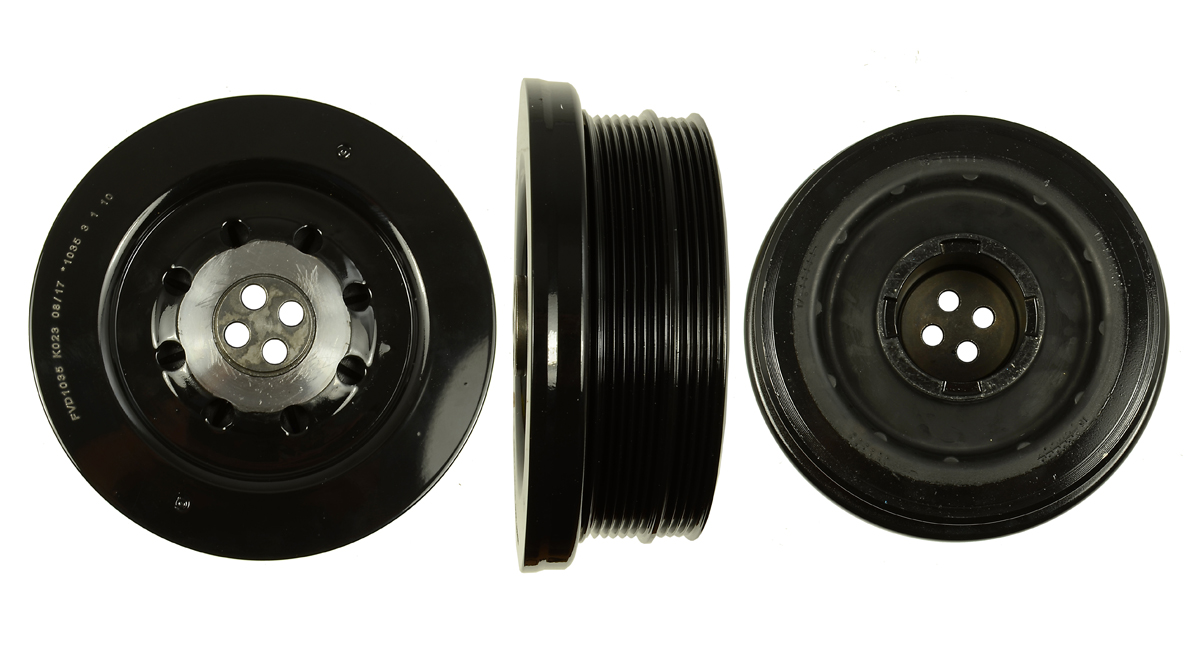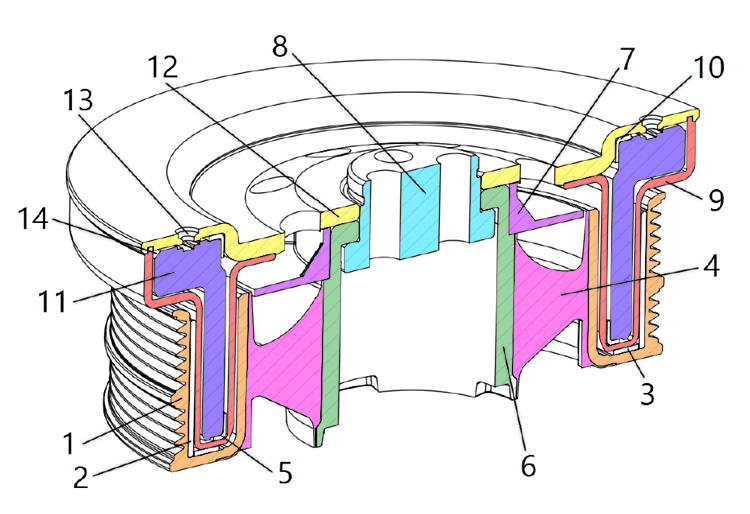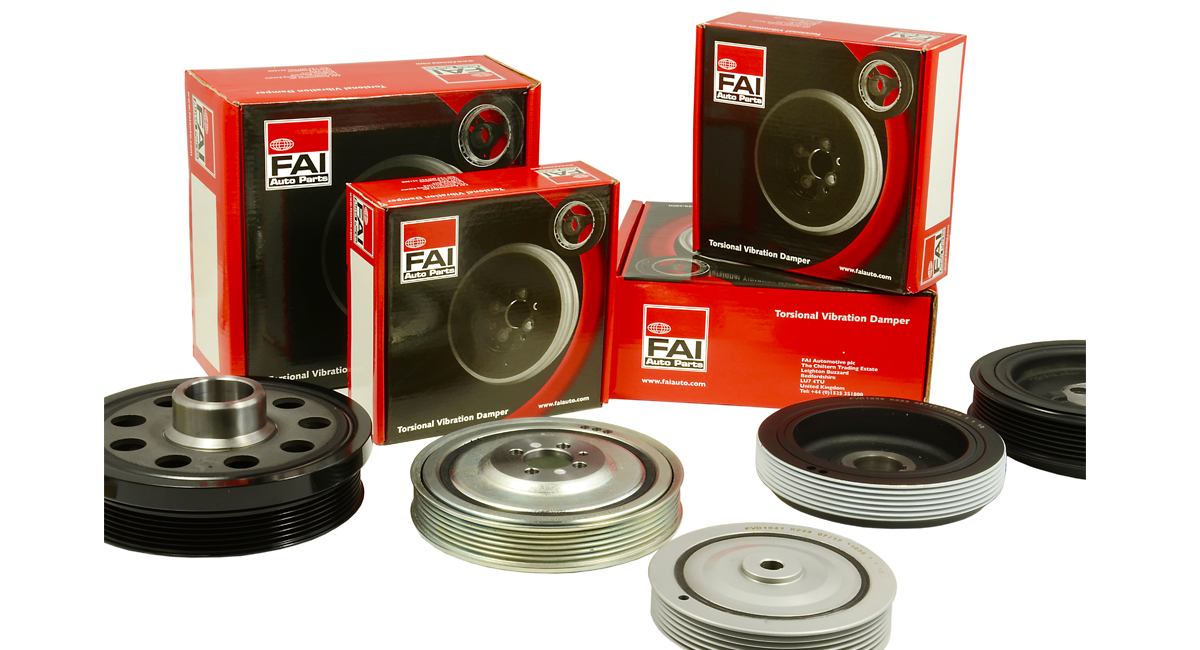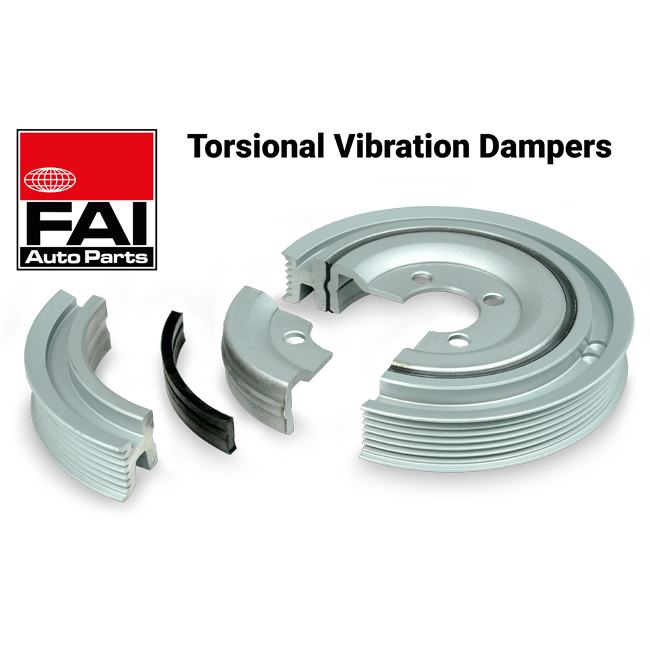Viscous Vibration Dampers
FAI recently introduced a range of 40+ Torsional Vibration Dampers. Torsional Vibration dampers come in various designs depending on application requirements. FVD1035, which is used on a lot of 3.0d BMWs, is one of the latest generation viscous couplings. In this article we will delve deeper into the technology of the Viscous coupling.
| BMW M57 3.0d | |
| 3 (E46) | 3 (E90/91/92/93) |
| 5 (E60/61) | 6 (E63/64) |
| 7 (E65 E66 E67) | X3 (E83) |
| X5 (E53) | X5 (E70) |
Viscous Dampers Design
A viscous damper has a sealed outer housing with a precision machined hub. Inside of the housing is an inertia ring with a viscous fluid (specialized silicone) filling the cavity.
| 1. Groove | 8. Inner Hub |
| 2. PTFE Bushing | 9. Inertia mass housing |
| 3. Plastic Bushing Plate | 10. Slide Bearing |
| 4. Rubber | 11. Inertia mass |
| 5. Slide Bearing | 12. Cover |
| 6. Main Hub | 13. Viscous Fluid hole |
| 7. Propeller | 14. Viscous fluid gap |
With a viscous damper, the hub and outer ring are moving with the crankshaft since they are directly connected to it. The inner fluid and inertia ring are moving only because of the shear force. As the crank rotates, the shear force is great enough to keep the fluid and inertia ring still relative to the outer ring (meaning everything is rotating at the same speed). As a combustion event happens, the harmonics oscillate the outer ring. The frequencies of these oscillations are high enough to create a rapid change in velocity which causes the free rotating internal inertia ring to be at a different speed than the outer ring. The fluid in-between the inertia ring and outer ring experiences a shear force that opposes the harmonics and helps to dissipate the harmonic energy as heat.
The silicon has a very high viscosity. As the change in velocity increases, it is being multiplied by this high viscosity resulting in a very high shear force. Another reason we use silicone is because of its thermal stability over a wide temperature range. The temperature range is -40 to 300 Fahrenheit meaning it can be used in very extreme temperature conditions and it remains an excellent dissipater of heat.” Heat is a by-product of damping harmonics and dissipating that heat away from the damping medium is critical for proper functioning of the damper over time.
With a fluid damper, the shear forces are acting anytime the crank is rotating. Once the harmonics get above a level to create a difference in rotational speed between the inertia ring and the outer ring, the damper is damping (which is most of the time).
Torsional vibration is the speed fluctuation of a rotating shaft. It has two components, twist and rigid body motion.
• Twist is the kind of vibration that is expected when you think of crankshaft torsional vibration. From one end of the shaft to another the vibration amplitudes change direction. When this happens there is a point where there is no vibration amplitude. This is called a nodal point. The material stresses are the highest at a nodal point.
• Rigid body motion is when the rotating shaft has torsional vibration but there is no nodal point along the shaft. The vibration does not change direction.
The outer housing is directly connected to the shaft and moves with shaft rotation. Inside, the inner inertia ring freely rotates in a thin layer of viscous fluid (Silicon). As a vibration event happens it causes the outer housing and inner inertia ring to rotate independently at different speeds. The resulting shear action through the viscous fluid diminishes the vibration by transforming it to heat.
Why Silicone![]()
Silicone has proven to be an excellent damping medium because it contributes to long damper life by exhibiting:
• High energy dissipation
• High tensile strength
• Effective across a broad range of frequencies and rpms
If they are that good, why aren’t they standard on all OEM engines?
Production of any mass produced item usually comes down to trade off’s. One of the biggest tradeoffs is cost vs. quality. If you can design a part to work with something that is cheaper, then you design it for something that is cheaper. When durability matters more, then you spend more. Such cases are often found in industrial applications. Many OEM’s for heavy duty diesel engines use viscous dampers because these machines power our economy and are subjected to very harsh conditions and are relied upon for business. Breaking or down time must be minimized.
Why choose FAI?
Manufactured to OE specification.
40+ Part Numbers in initial range.
Each TVD contains Harmonic Damper.
Competitive pricing.
First class cataloguing.




